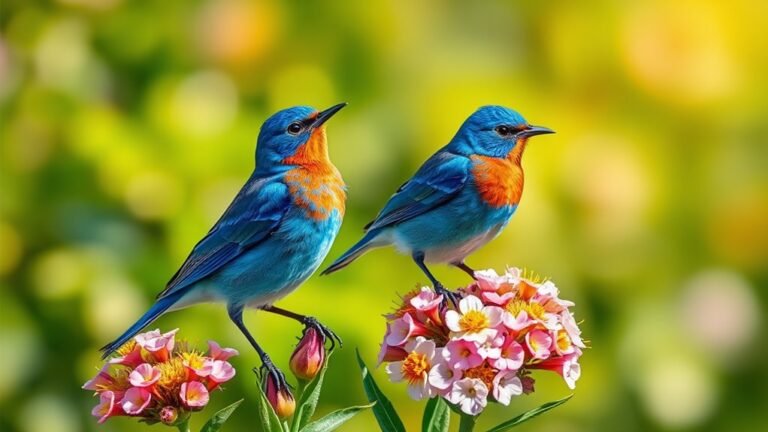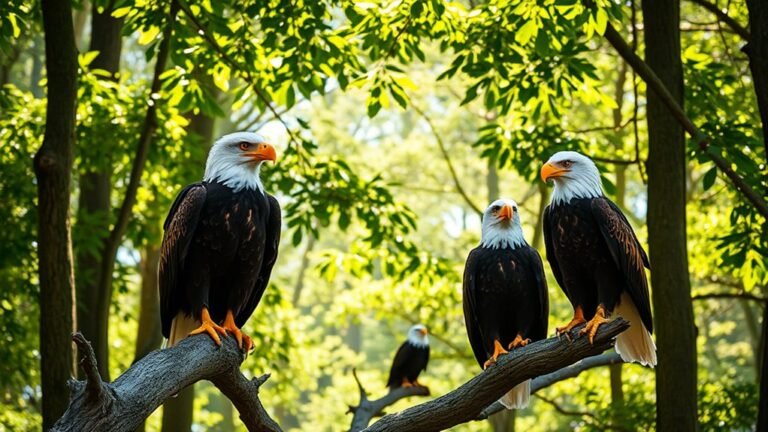Birds That Look Like Crows: Dark, Intelligent Birds
Crows, ravens, and jays are dark-feathered birds known for their intelligence. They show strong problem-solving abilities and have complex social structures. These traits help them adapt and survive in different environments, both urban and natural.
Crows often find food sources in cities. They can use tools, remember human faces, and communicate with one another. Ravens are known for their playful behavior and social bonding. Jays are known to hide and store food for later use, showing an ability to plan ahead.
These adaptations allow them to thrive in a wide range of habitats. Their intelligence and resourcefulness make them significant players in maintaining ecological balance. Understanding these abilities enhances our appreciation for these remarkable birds and their roles in our ecosystems.
Key Takeaways
- Common Ravens are larger than crows and have wedge-shaped tails. They are known for their intelligence and adaptability.
- Hooded Crows feature a distinct gray and black coloration. They thrive in urban and coastal areas and show strong problem-solving skills.
- Carrion Crows are adaptable and resourceful birds. You can easily identify them by their dark feathers and scavenging behavior.
- Fish Crows are smaller birds found along coastlines. They are known for their unique calls and for feeding on mollusks and carrion.
- Northwest Crows share a similar dark color with other crows. They exhibit intelligence and have complex social structures in coastal and forest areas.
The Common Raven: A Larger, Smarter Relative
Common ravens (Corvus corax) are larger and more intelligent than crows. You can identify them by their wedge-shaped tails and greater size.
Ravens demonstrate impressive problem-solving skills, comparable to those of primates. They engage in social interactions and use various calls to communicate. This shows their advanced understanding of sounds and visual cues.
Ravens can also mimic sounds from their surroundings, highlighting their adaptability. Observing these birds offers insights into their social behavior and communication methods, deepening your connection to nature.
The American Crow: An Adaptable Survivor
When you see an American crow (Corvus brachyrhynchos) in cities or the countryside, you're looking at a bird that has adapted well to different environments.
These crows find food in various places, like parks, dumpsters, and streets. They change their behavior to fit in with human settings. Their social groups help them work together to find food, which increases their chances of survival.
They also show great problem-solving skills and can use tools. Recognizing these clever birds in our spaces connects us to nature and highlights our own ability to adapt.
The Hooded Crow: A Blend of Beauty and Brains
The Hooded Crow (Corvus cornix) attracts birdwatchers and researchers with its beautiful look and strong intelligence. This bird lives in coastal areas and cities across Europe and western Asia. Its feathers mix gray and black, creating a striking appearance.
Hooded Crows show interesting behaviors. They've social groups and solve problems effectively, showing their smart nature. They use tools and find new ways to get food.
Living in close groups, they communicate in complex ways, building community ties.
The Carrion Crow: the Scavenger With a Sharp Mind
The Carrion Crow (Corvus corone) stands out for its intelligence and adaptability. Unlike the Hooded Crow, which captures attention with its looks, the Carrion Crow demonstrates keen problem-solving skills and resourcefulness.
These birds use tools to help obtain food and often work together to find meals.
Carrion Crows primarily eat dead animals, but they also eat leftovers from human activity. This flexible diet allows them to thrive in cities, where they search for discarded food.
Observing Carrion Crows reveals their ability to adapt to different environments. Their sharp minds and awareness of their surroundings establish them as one of nature's cleverest scavengers.
The Eurasian Jay: A Colorful Member of the Corvid Family
The Eurasian Jay (Garrulus glandarius) is a stunning bird that stands out due to its bright colors and smart behavior.
This bird lives in various places, such as forests, parks, and gardens. Its blue wings and chestnut body make it visually appealing.
Observing the Eurasian Jay shows its intelligence. It can solve problems and mimic sounds effectively.
While searching for food, it hides acorns, highlighting its ability to remember and plan.
The Eurasian Jay contributes to local ecosystems with its adaptability and social interactions in groups.
Watching these birds in action lets you appreciate their beauty and skills.
The Fish Crow: Master of Coastal Habitats
The Fish Crow (Corvus ossifragus) is a unique bird found in coastal areas. It thrives in habitats like marshes, beaches, and estuaries.
Here are three important facts about the Fish Crow:
- Diet: Fish Crows are opportunistic eaters. They consume a variety of foods, including mollusks and carrion. This flexibility allows them to thrive in different environments.
- Social Structure: Fish Crows often gather in groups. They show social behaviors that help them build strong connections with one another. This teamwork is vital for their survival.
- Vocalization: Fish Crows have distinct calls that can be heard in their habitat. These sounds help them communicate, which is crucial for their daily activities.
Fish Crows are fascinating creatures that play an important role in their coastal ecosystems.
The Northwest Crow: A Lesser-Known Twin of the American Crow
The Northwest Crow (Corvus caurinus) is an interesting bird that thrives in the coastal regions and forests of the Northwest. This crow is smaller than the more familiar American Crow and has distinct vocalizations that set it apart.
Like the American Crow, the Northwest Crow shows great intelligence. It uses tools and has complex social structures. Observing its behavior offers insights into its social life and intelligence.
While not as well-known, learning about the Northwest Crow can deepen your appreciation for birds and connect you with others who admire these fascinating creatures.
Frequently Asked Questions
Do Crows and Ravens Have Different Vocalizations?
Crows and ravens have different sounds. Crows make a harsh caw, while ravens produce deeper and varied calls. These vocal differences reflect their social interactions and how they adapt to their environment. The unique sounds of each bird add richness to bird communication.
Can Crows Recognize Human Faces?
Crows can recognize human faces. They observe human interactions and make associations based on those observations. This ability helps crows adapt and survive in their environments. Their intelligence allows them to navigate urban settings alongside people. Crows become fascinating companions in these areas due to their unique skills and social behavior.
What Is the Lifespan of a Crow?
The average lifespan of a crow is between 10 and 15 years. In urban areas, crows can live longer, sometimes reaching 20 years or more. This is due to easy access to food and fewer natural predators, which helps them adapt and survive. Crows are intelligent birds that thrive in various environments. Their ability to find food and avoid danger contributes to their longer lives in cities.
What Do Crows Eat in the Wild?
Crows eat insects, seeds, fruits, and small animals. They adapt their diet based on what is available. Their food choices can change with the seasons and their surroundings. This adaptability shows how smart they are when foraging. Crows display impressive problem-solving skills and often find food in various places. Their varied diet helps them thrive in different environments. Overall, crows are resourceful feeders that play an important role in their ecosystem.
How Are Crows Related to Other Bird Species?
Crows are closely related to other corvids, such as ravens and jays. They share similar genetic traits, showing their common ancestry. Studying these traits helps us understand how bird species connect. This knowledge raises awareness about biodiversity and the relationships in nature. Exploring crows can be fascinating, as these intelligent birds exhibit unique behaviors, reminding us of the rich variety of life around us.

Ava is a bird enthusiast and nature lover who has spent countless hours observing and learning about the fascinating world of birds. With a passion for sharing her knowledge and inspiring others to appreciate the beauty of birds, Ava writes about her experiences and insights on avianadmirer.com.







